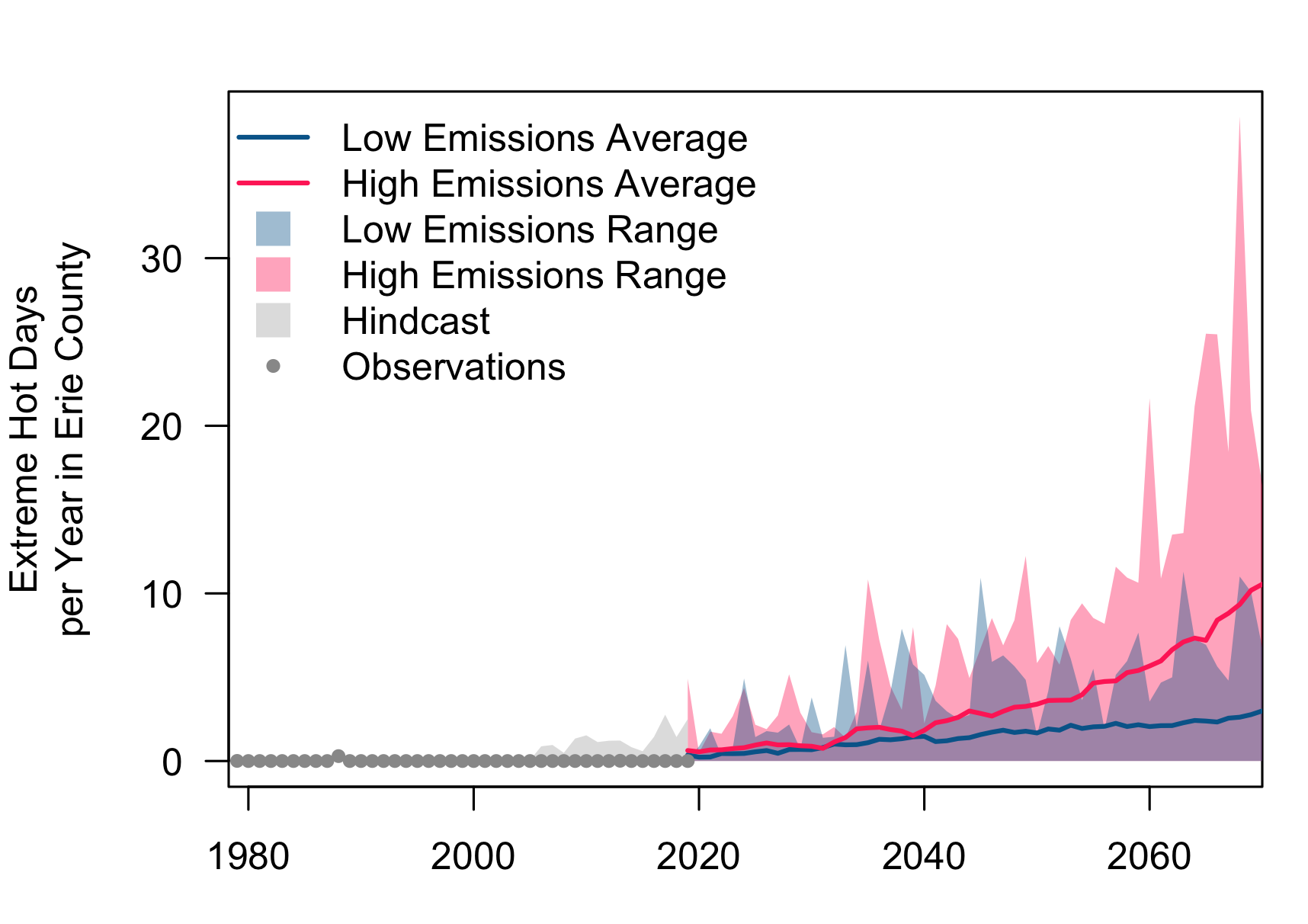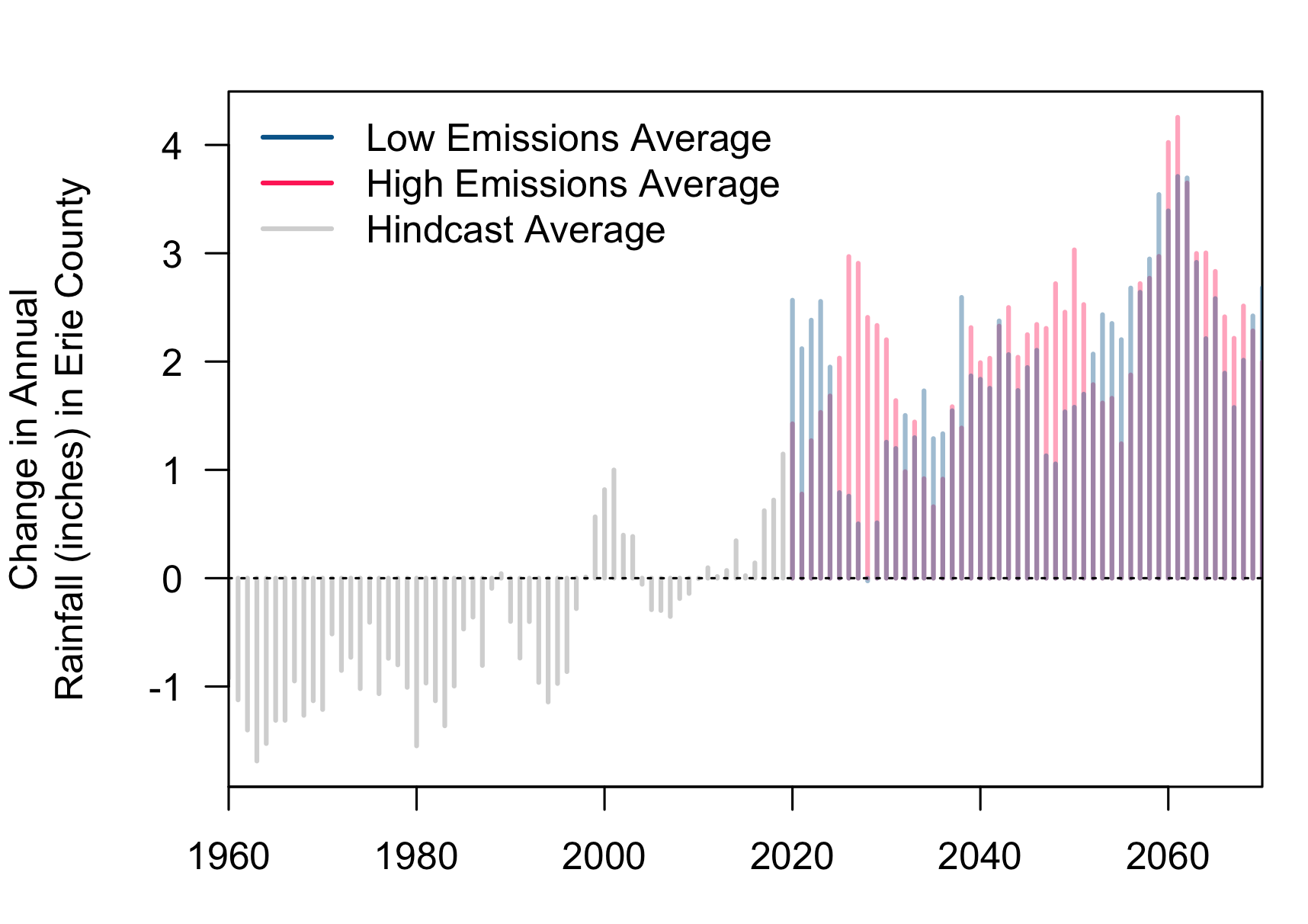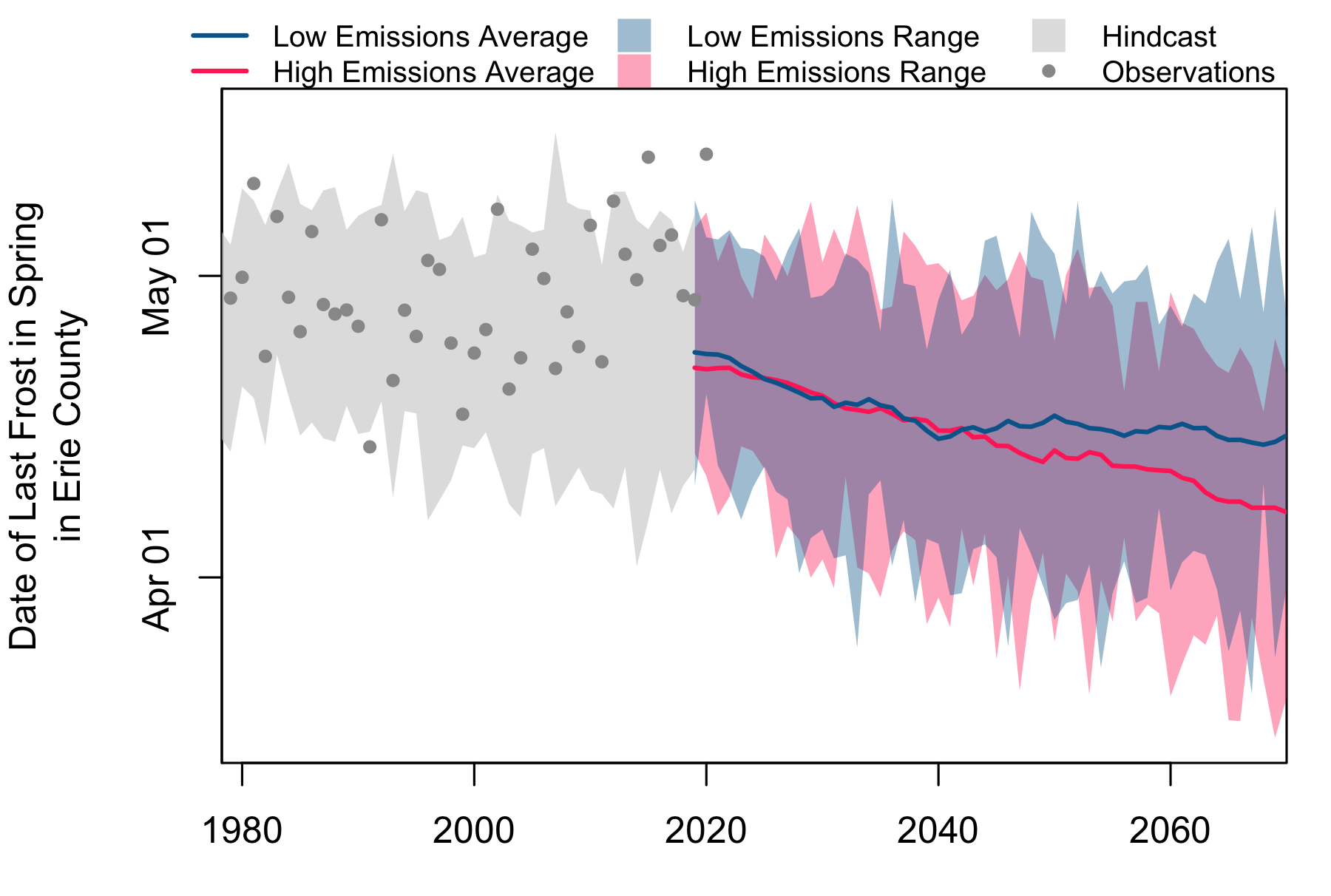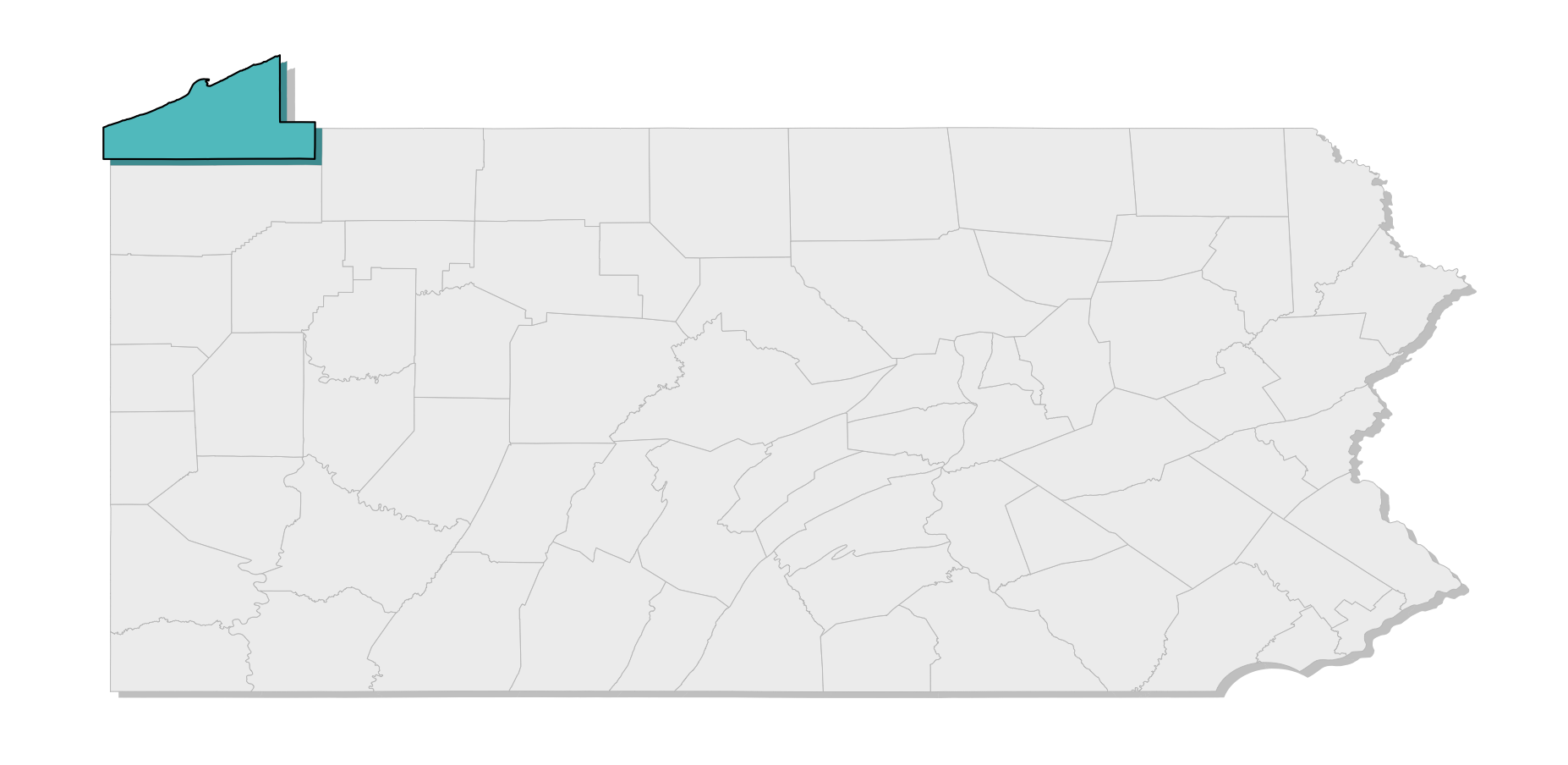Erie County, PA
Erie County residents will face increasingly severe weather-related hazards, such as heat waves, flooding, and shifting seasons.
As the frequency and intensity of local hazards change, it is important for all of us to protect communities and local habitats. Using the best data, scientists can project how long-term averages in daily weather will change in the future, and the effects this will have on localities.
Information on extreme weather and hazards can empower citizens, decision-makers, and other stakeholders to make infored risk-reduction decisions. With planning and preparation, Erie County can reduce risks for all residents.

Changing Temperature Patterns
Human health, lake health, and infrastructure are all threatened by higher temperatures. At 95°F, it is hard to keep indoor areas and our bodies cool. Erie County’s summers are getting hotter and dead zones1 are worsening. Over the past 30 years, it was rare to have any days with temperatures above 95°F in Erie County. Within the next 50 years (by 2070), Erie County can expect a yearly average of 3 to 11 days above 95°F, with associated increases in cooling costs, reduced air quality, and heat-related illnesses.
![]() HEAT-RELATED ILLNESSES: Heatwaves can kill people and pets. In Pennsylvania, more than 80 people have died from extreme heat between 2010 and 2019. Individuals at higher risk include children, pregnant women, older adults, outdoor workers, and lower-income residents.
HEAT-RELATED ILLNESSES: Heatwaves can kill people and pets. In Pennsylvania, more than 80 people have died from extreme heat between 2010 and 2019. Individuals at higher risk include children, pregnant women, older adults, outdoor workers, and lower-income residents.
![]() REDUCED LAKE HEALTH: Across the Great Lakes, surface water temperature has increased. Warmer water expands dead zones and the range of invasive species like zebra mussels in Lake Erie, which threaten the survival of yellow perch, walleye, and steelhead, disrupting local fisheries and ecosystems. Warmer water also worsens algal blooms which can close beaches and contaminate drinking water.
REDUCED LAKE HEALTH: Across the Great Lakes, surface water temperature has increased. Warmer water expands dead zones and the range of invasive species like zebra mussels in Lake Erie, which threaten the survival of yellow perch, walleye, and steelhead, disrupting local fisheries and ecosystems. Warmer water also worsens algal blooms which can close beaches and contaminate drinking water.

The graph shows the number of days in a year with temperatures above or equal to 95°F. Dots represent observed annual days of extreme temperatures and the gray shading shows the hindcast2. Two scenarios of the future are shown as a high-emissions scenario (RCP 8.5) in red and a low-emissions scenario (RCP 4.5) in blue. Data for the future scenarios are retrieved from Multivariate Adaptive Constructed Analogs (MACA), and observed data are from the Gridded Surface Meteorological Dataset (gridMET).
Changing Rainfall Patterns
Heavy rainfall in Erie County is increasing in frequency and intensity, causing property damage, septic backups, well contamination, mold and indoor air quality issues, fluctuations of water level in Lake Erie, and impacts to water quality in local streams, rivers, and Lake Erie. Annual rainfall in Erie County will likely increase by an average of 2 to 3 inches (2050-2079 average compared to the 1990-2019 average).
![]() FLOODING: Heavy rain overwhelms infrastructure and drainage systems, causing property damage and increasing lake water levels. It can quickly cover streets and become deadly to drivers.
FLOODING: Heavy rain overwhelms infrastructure and drainage systems, causing property damage and increasing lake water levels. It can quickly cover streets and become deadly to drivers.
![]() REDUCED HUMAN HEALTH: Rising water tables cause septic backups and groundwater pollution, putting drinking water at risk of contamination. Changing moisture levels impact the spread of mold and illness, including tick- and mosquito-borne diseases as high humidity promote their activity.
REDUCED HUMAN HEALTH: Rising water tables cause septic backups and groundwater pollution, putting drinking water at risk of contamination. Changing moisture levels impact the spread of mold and illness, including tick- and mosquito-borne diseases as high humidity promote their activity.

The graph shows the change in annual rainfall compared to the average between 1990 and 2019. The gray lines show the hindcast. Two scenarios of the future are shown as a high-emissions scenario (RCP 8.5) in red and a low-emissions scenario (RCP 4.5) in blue. Data for the future scenarios are retrieved from MACA.
Shifting Seasons
Seasons are changing in length and timing in Erie County with an earlier spring, delay of fall, and a shorter winter with less ice covering Lake Erie. While a longer frost-free period can benefit some crops or allow for double cropping, it can limit plant diversity including wine grape varieties, encourage invasive species, and threaten human and ecosystem health. Within the next 50 years (by 2070), the frost-free period will average 4 to 7 weeks longer in Erie County.
![]() REDUCED HUMAN HEALTH: Milder winters help more ticks and mosquitos survive the winter and earlier springs make their biting season longer. Earlier springs also cause trees and flowers to bloom earlier leading to a longer allergy season.
REDUCED HUMAN HEALTH: Milder winters help more ticks and mosquitos survive the winter and earlier springs make their biting season longer. Earlier springs also cause trees and flowers to bloom earlier leading to a longer allergy season.
![]() REDUCED ICE COVER: Shorter winters and warmer water in Lake Erie increase the evaporation season length and delay ice formation. Ice cover on Lake Erie has decreased by 50% between 1973 and 2010. While reduced ice cover keeps shipping lanes open longer in winter, lower lake levels can force ships to reduce their cargo load and cause erosion. Reduced ice cover also increases lake effect snow and disrupts ice fishing.
REDUCED ICE COVER: Shorter winters and warmer water in Lake Erie increase the evaporation season length and delay ice formation. Ice cover on Lake Erie has decreased by 50% between 1973 and 2010. While reduced ice cover keeps shipping lanes open longer in winter, lower lake levels can force ships to reduce their cargo load and cause erosion. Reduced ice cover also increases lake effect snow and disrupts ice fishing.

The graph shows the date of the last frost (less than or equal to 32°F) in spring. Dots represent observed dates of the last frost in spring and the gray shading shows the hindcast. Two scenarios of the future are shown as a high-emissions scenario (RCP 8.5) in red and a low-emissions scenario (RCP 4.5) in blue. Data for the future scenarios are retrieved from Multivariate Adaptive Constructed Analogs (MACA), and observed data are from the Gridded Surface Meteorological Dataset (gridMET).
Development of the Local Hazard Outlooks was supported by the National Oceanic and Atmospheric Administration (NOAA) grants NA18OAR4310302 and NA21OAR4310310.
v2.0-beta1 2025-06-04
